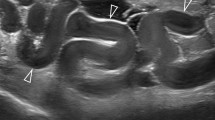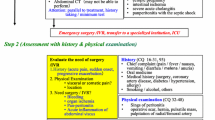Abstract
Ultrasonography (US) is an invaluable tool in the management of many types of patients in Internal Medicine and Emergency Departments, as it provides rapid, detailed information regarding abdominal organs and the cardiovascular system, and facilitates the assessment and safe drainage of pleural or intra-abdominal fluid and placement of central venous catheters. Bedside US is a common practice in Emergency Departments, Internal Medicine Departments and Intensive Care Units. US performed by clinicians is an excellent risk reducing tool, shortening the time to definitive therapy, and decreasing the rate of complications from blind invasive procedures. US can be performed at different levels of practice in Internal Medicine, according to the experience of ultrasound practitioners and equipment availability. In this review, the indications for bedside US that can be performed with basic or intermediate US training will be highlighted.



Similar content being viewed by others
References
American College of Emergency Physicians (2009) Emergency ultrasound guidelines. Ann Emerg Med 53:550–570
Reardon R, Heegaard B, Plummer D, Clinton J, Cook T, Tayal V (2006) Ultrasound is a necessary skill for emergency physicians. Acad Emerg Med 13:334–336
Beaulieu Y, Marik PE (2005) Bedside ultrasonography in the ICU (Part 1). Chest 128:881–895
Beaulieu Y, Marik PE (2005) Bedside ultrasonography in the ICU (Part 2). Chest 128:1766–1781
Valentin L (2006) Minimum training recommendations for the practice of medical ultrasound. Ultraschall Med 27:79–105
Cardenas E (1998) Limited beside ultrasound imaging by emergency medicine physicians. West J Med 168:188–189
Bassler D, Snoey ER, Kim J (2003) Goal-directed abdominal ultrasonography: impact on real-time decision making in the emergency department. J Emerg Med 24:375–378
Kuhn M, Bonnin RL, Davey MJ, Rowland JL, Langlois SL (2000) Emergency department ultrasound scanning for abdominal aortic aneurysm: accessible, accurate, and advantageous. Ann Emerg Med 36:219–223
Tayal VS, Graf CD, Gibbs MA (2003) Prospective study of accuracy and outcome of emergency ultrasound for abdominal aortic aneurysm over two years. Acad Emerg Med 10:867–871
American Institute of Ultrasound in Medicine (2008) AIUM Practice Guideline for the performance of the focused assessment with sonography for trauma (FAST) examination. J Ultrasound Med 27:313–318
Miller AH, Pepe PE, Brockman CR, Delaney KA (2006) ED ultrasound in hepatobiliary disease. J Emerg Med 30:69–74
Durston W, Carl ML, Guerra W, Eaton A, Ackerson L, Rieland T, Schauer B, Chisum E, Harrison M, Navarro ML (2001) Comparison of quality and cost-effectiveness in the evaluation of symptomatic cholelithiasis with different approaches to ultrasound availability in the ED. Am J Emerg Med 19:260–269
Ralls PW, Colletti PM, Lapin SA, Chandrasoma P, Boswell WD Jr, Ngo C, Radin DR, Halls JM (1985) Real-time sonography in suspected acute cholecystitis: prospective evaluation of primary and secondary signs. Radiology 155:767–771
Harvey RT, Miller WT Jr (1999) Acute biliary disease: initial CT and follow-up US versus initial US and follow-up CT. Radiology 213:831–836
Baron RL, Stanley RJ, Lee JK, Koehler RE, Melson GL, Balfe DM, Weyman PJ (1982) A prospective comparison of the evaluation of biliary obstruction using computed tomography and ultrasonography. Radiology 145:91–98
Gaspari RJ, Horst K (2005) Emergency ultrasound and urinalysis in the evaluation of flank pain. Acad Emerg Med 12:1180–1184
Anton HA, Chambers K, Clifton J, Tasaka J (1998) Clinical utility of a portable ultrasound device in intermittent catheterization. Arch Phys Med Rehab 79:172–175
Durham B, Lane B, Burbridge L, Balasubramaniam S (1997) Pelvic ultrasound performed by emergency physicians for the detection of ectopic pregnancy in complicated first-trimester pregnancies. Ann Emerg Med 29:338–347
Mandavia DP, Aragona J, Chan L, Chan D, Henderson SO (2000) Ultrasound training for emergency physicians. Acad Emerg Med 7:1009–1014
Promes SB, Nobay F (2010) Pitfalls in first-trimester bleeding. Emerg Med Clin North Am 28:219–234
Dietrich CF (2008) Ultrasonography of the small and large intestine. In: UpToDate, Rose BD (eds), UpToDate, Wellesley
Doria AS, Moineddin R, Kellenberger CJ, Epelman M, Beyene J, Schuh S, Babyn PS, Dick PT (2006) US or CT for diagnosis of appendicitis in children and adults? A meta-analysis. Radiology 241:83–94
Poortman P, Oostvogel HJ, Bosma E, Lohle PN, Cuesta MA, de Lange-de Klerk ES, Hamming JF (2009) Improving diagnosis of acute appendicitis: results of a diagnostic pathway with standard use of ultrasonography followed by selective use of CT. J Am Coll Surg 208:434–441
Puylaert JB (2001) Ultrasound of acute GI tract conditions. Eur Radiol 11:1867–1877
Stengel D, Bauwens K, Rademacher G, Mutze S, Ekkernkamp A (2005) Association between compliance with methodological standards of diagnostic research and reported test accuracy: meta-analysis of focused assessment of US for trauma. Radiology 236:102–111
Melniker LA, Leibner E, McKenney MG, Lopez P, Briggs WM, Mancuso CA (2006) Randomized controlled clinical trial of point-of-care, limited ultrasonography for trauma in the emergency department: the first sonography outcomes assessment program trial. Ann Emerg Med 48:227–235
Mackersie RC (2010) Pitfalls in the evaluation and resuscitation of the trauma patient. Emerg Med Clin North Am 28:1–27 Vii
Chan SS (2003) Emergency bedside ultrasound to detect pneumothorax. Acad Emerg Med 10:91–94
Lichtenstein DA, Mezière G, Lascols N, Biderman P, Courret JP, Gepner A, Goldstein I, Tenoudji-Cohen M (2005) Ultrasound diagnosis of occult pneumothorax. Crit Care Med 33:1231–1238
Cogo A, Lensing AW, Koopman MM, Piovella F, Siragusa S, Wells PS, Villalta S, Büller HR, Turpie AG, Prandoni P (1998) Compression ultrasonography for diagnostic management of patients with clinically suspected deep vein thrombosis: prospective cohort study. BMJ 316:17–20
Tick LW, Ton E, van Voorthuizen T, Hovens MM, Leeuwenburgh I, Lobatto S, Stijnen PJ, van der Heul C, Huisman PM, Kramer MH, Huisman MV (2002) Practical diagnostic management of patients with clinically suspected deep vein thrombosis by clinical probability test, compression ultrasonography, and d-dimer test. Am J Med 113:630–635
Burnside PR, Brown MD, Kline JA (2008) Systematic review of emergency physician-performed ultrasonography for lower-extremity deep vein thrombosis. Acad Emerg Med 15:493–498
Bernardi E, Camporese G, Büller HR, Siragusa S, Imberti D, Berchio A, Ghirarduzzi A, Verlato F, Anastasio R, Prati C, Piccioli A, Pesavento R, Bova C, Maltempi P, Zanatta N, Cogo A, Cappelli R, Bucherini E, Cuppini S, Noventa F, Prandoni P (2008) Erasmus Study Group. Serial 2-point ultrasonography plus d-dimer vs whole-leg color-coded Doppler ultrasonography for diagnosing suspected symptomatic deep vein thrombosis: a randomized controlled trial. JAMA 300:1653–1659
Righini M, Bounameaux H (2008) Clinical relevance of distal deep vein thrombosis. Curr Opin Pulm Med 14:408–413
Kearon C, Julian JA, Newman TE, Ginsberg JS (1998) Noninvasive diagnosis of deep venous thrombosis McMaster Diagnostic Imaging Practice Guidelines Initiative. Ann Intern Med 128:663–677
Goodacre S, Sampson F, Thomas S, van Beek E, Sutton A (2005) Systematic review and metaanalysis of the diagnostic accuracy of ultrasonography for deep vein thrombosis. BMC Med Imaging 5:6
Blaivas M, Fox J (2001) Outcome in cardiac arrest patients found to have cardiac standstill on the bedside emergency department echocardiogram. Acad Emerg Med 8:616–621
DeCara JM, Lang RM, Koch R, Bala R, Penzotti J, Spencer KT (2003) The use of small personal ultrasound devices by internists without formal training in echocardiography. Eur J Echocardiogr 4:141–147
Duvall WL, Croft LB, Goldman ME (2003) Can hand-carried ultrasound devices be extended for use by the noncardiology medical community? Echocardiography 20:471–476
Soldati G, Gargani L, Silva FR (2008) Acute heart failure: new diagnostic perspectives for the emergency physician. Intern Emerg Med 3:37–41
Nazeer SR, Dewbre H, Miller AH (2005) Ultrasound-assisted paracentesis performed by emergency physicians vs the traditional technique: a prospective, randomized study. Amer J Emerg Med 23:363–367
Milling TJ Jr, Rose J, Briggs WM, Birkhahn R, Gaeta TJ, Bove JJ, Melniker LA (2005) Randomized, controlled clinical trial of point-of-care limited ultrasonography assistance of central venous cannulation: The third sonography outcomes assessment program (SOAP-3) trial. Crit Care Med 33:1764–1769
Randolph AG, Cook DJ, Gonzales CA, Pribble CG (1996) Ultrasound guidance for placement of central venous catheters: a metaanalysis of the literature. Crit Care Med 24:2053–2058
Conflict of interest
None.
Author information
Authors and Affiliations
Corresponding author
Rights and permissions
About this article
Cite this article
Arienti, V., Camaggi, V. Clinical applications of bedside ultrasonography in internal and emergency medicine. Intern Emerg Med 6, 195–201 (2011). https://doi.org/10.1007/s11739-010-0424-3
Received:
Accepted:
Published:
Issue Date:
DOI: https://doi.org/10.1007/s11739-010-0424-3




